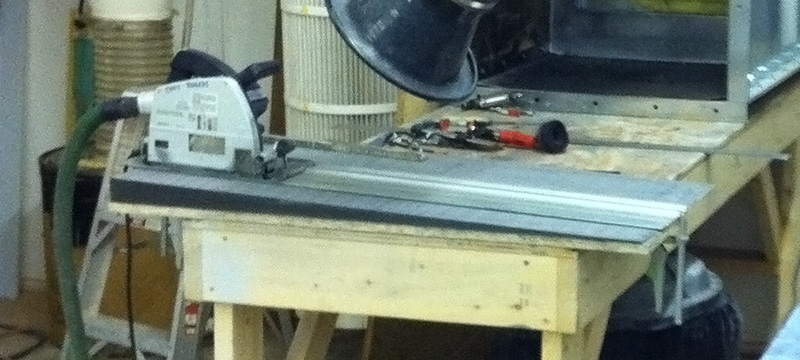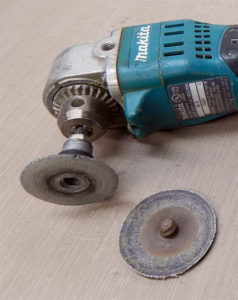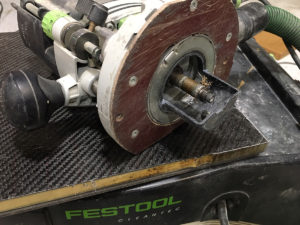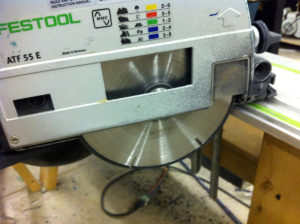There was a time when I thought Festool tools were expensive and gimmicky and definitely not for me. I used REAL tools – my Bosch jigsaw, Porter Cable routers, Milwaukee drills and a whole bunch of cordless Makita and Dewalt items. I sanded with pneumatic sanders and ground with die grinders and a paddle-switch Dewalt grinder – with the guard removed of course! I had worked with a few travelling boat-builders who used Festool gear but for the most part I hadn’t given them much thought. They were European tools with funny plugs – for people who measured everything in millimeters.
Then I went to work for a racing team that had set up shop and spend a bunch of money outfitting the place with the nicest set of equipment and hand tools I had ever seen. The tool room had dozens of Festool vacuums and plunge saws and routers and drills and guide rails 10 feet long. I was impressed, but not convinced. Then I started to work with them…
The stuff was fussy for sure – and it wasn’t always obvious at first how the buttons work, or how to change a blade – but the dust collection was unlike anything I could have imagined. I had become totally used to feeling the hot plume of dust whipping off a grinder disk and hitting my already blackened Tyvek suit. Tents, grinding rooms and big dust extractors – and full-face respirators – were just a day-to-day reality. I taped my gloves to the suit sleeves and then put a second set of gloves over the top. I was also used to making huge messes – and spending lots of time itching! The Festool tools – especially the routers, track saws and sanders – were amazing. The dust went in the vacuum – most of it anyway – and not on me. I was coming around!
When that job was over I started looking for Festool stuff on craigslist. Right away I bought a vacuum and a plunge saw. Then I bought a router and a sander new. A few months later I bought what may be my favorite power-tool ever – the RAS 115 grinder. When I started my own shop I kept an eye out on the used market and bought some more vacuums, sanders, and a jigsaw. I was hooked! Dust control was the biggest motivator, but precision and control were amazing too. They were just a joy to use!
Value

It’s easy to look at Festool gear and think “holy crap this stuff is expensive!” I know I did – and still do. My feeling is that the price is high but the overall value is very competitive. You have to buy into the “ecosystem” to get the benefits though – and this means several thousand dollars at a minimum. For me this has been money well spent – especially doing composites work. From sawing accurate cuts in tooling materials by myself with a track saw to routing 20mm carbon bulkhead flanges inside a boat without making a massive mess – the value is made up in easier setups, neater work and less mess. You pay up front and then you have an incrementally better experience for years. Making every job 5% easier or faster is huge in the long run. For less nasty materials like wood I am not sure the value proposition is as strong as for composites – but 99% of the tools are sold to woodworkers so they must feel the value too.
Another benefit that isn’t always recognized is the emotional one. Working with nice tools feels better then working with junky tools. Buying nice tools for your employees to use makes them feel like you value their time and want them to be awesome. Having crappy old broken hard to use and unsafe tools sends a terrible message to people who work with you – that you don’t respect their experience and are a total cheapskate who doesn’t mind having them struggle. I have worked in places with awesome tools and places where it took half an hour just to find a vacuum cleaner. It’s obvious to me where I was more efficient and where I did better work. Relatively little things like the quality of the tools (you might pay more for insurance or heat in one year than for all your hand tools combined) send big powerful messages about what kind of place you want to be. Nice tools are a cheap way to signal a focus on quality and efficiency – as well as faith in your team to care for nice things.
After ten years using these tools – all of them are still working – I am still very glad I paid the extra money for the best dust collection available for small power tools. The Festool gear is also remarkably durable. There are definitely broken bits on almost all my tools – but replacements are readily available. You pay a lot – but you get what you pay for – and then some.
Sanders
Starting with sanders, I have a RO 150 Rotex Sander which is a beast. It has two modes: orbital and rotary. This is great because it broadens the useful range of the tool at ton. It can go nuts on solid fiberglass with 36 grit and then prep a surface for paint with 320 grit. There is even a polishing setup available which is not as powerful as a larger buffer, but great for small surfaces where you need more control. I also have an EQ-150 Random Orbital Sander which uses the same paper is is better for light sanding – prepping surfaces or primers. It is much smaller and lighter than the Rotex and can be one-handed if necessary. The smaller 90mm Rotex looks like it might be a decent substitute for there RAS-115 grinder (see below) but I don’t own one – yet!
Grinder

Probably my favorite (toss up with the router) is the RAS-115 Rotary Sander. I understand this is being discontinued – hopefully they’ll replace it with something similar. I have an unopened backup stashed away! This machine changed how I think about grinding. It has great RPM control and a little brushy dust catcher that you can move by twisting the 90 degree handle. Instead of grabbing a 4 1/2″ metal working grinder and blasting away, this tools lets you work more carefully and remove material with the pad flat on the surface instead of up on an angle. The variable speed is great and lets you use heavier grit paper to remove a smaller amount of material with less digging and gouging. It is a grinding game-changer!
I find that with this RAS-115 and a right angle drill with a Rota-loc 2″ grinding disk – also an awesome combo – almost all light grinding operations are easier and more precise. And you should always avoid heavy grinding situations!
The one down-side is that the Velcro pads that hold the paper can heat up and wear out. If you overheat the pad by pressing too hard or if the paper gets damaged, the Velcro gets worn off and then the pads don’t hold the disks as well. At $20+ per pad, this gets expensive. Some care is needed and I consider the pads a wear item. Dust collection is great but not 100% – especially at higher RPMs. But if I have to grind – this is my go-to almost every time.
Even if you can’t find one of these anymore, the lesson of variable-speed grinding is worth paying attention to – sometimes you don’t need all the RPM! Many tool manufacturers make variable speed grinders, which can really reduce the dust cloud to a manageable level and make catching more if it with a vacuum or dust extractor possible.
Routers

So the routers are my favorite too – and mostly for the awesome little cup that extends below the base to grab all the dust coming off the cutter. I use lots of diamond grit router bits for trimming composite flanges and copy-cutting to patterns. The cup sometimes gets in the way and you have to remove it for tight inside corners – but when it’s there it gets 90%+ of the dust. The router bases are easily adjustable and once you figure out what all the dials and buttons do, very intuitive. I have an OF 1400 EQ Router – the middle size one – and it is my favorite router ever – by a mile! I also have the huge one – the OF 2200 OB Router – and it is great for heavy duty material removal but it too heavy to one-hand. I bought it as a demo and it was half price – so that tipped the scales. It is a beast though but I’m not sure I’d buy it again – especially at full price – unless I were doing more wood working and swinging big cutters.
Track Saws

Track saws are sort of their own category – halfway between a traditional circular saw and a table-saw. I certainly use mine for lots of things I would have used a table saw for – and for a while I didn’t even own a table saw. For composite work, I mostly use it to cut up tooling materials – urethane board and MDF for molds. My saws are the TS 55 – smaller ones – and in hindsight I wish I had bought a TS 75 which is larger and has a 70mm depth of cut. The TS 55 doesn’t quite cut through 50mm tooling board which is kind of a bummer! I have also used the saw to cut carbon plate – sometimes in multiple passes up to 40mm thick. I had a diamond blade made custom to fir the arbor and diameter (about $150 US) with gulleted geometry and grit rim. This is an incredible addition to this saw. The dust collection is amazing and the cuts are clean and plumb. Unless you have a wet-saw this is far and away the best way to cut plate or cored panels. You can overheat the saws pretty easily if you bog them down so it pays to take small bites and not over-work the motor.
In the last 10 years track saws have become a standard offering from many manufacturers and I am not sure the Festool is always better-enough to justify the price. I have used Makita and Dewalt track saws and while they aren’t as refined as the Festool, they are probably a better value. Most manufacturers also offer cordless track-saws which I think would be nice, but as long as you have a vacuum hose, I’m not sure how valuable cordless would be. It’s probably good though!
Vacuums
The whole system doesn’t work without vacuums – I mean “Dust Extractors.” I have some previous generation CT-33 vacuums as well as a newer CT-36 and they are just bulletproof. One fell off staging and busted open but besides a broken bag it went back together and was fine. The bags are expensive. That’s the big downside – but the filters are great and especially for nasty composites dust – it is totally worth it. Hoses are durable but will wear out. I have replaced the ends (easy once you see how it works) and spliced hoses with tape. Surprising lengths are doable without losing suction – if you can stomach the money to buy long hoses! I have also had the plug sockets rip out of the older vacuums but it is easy enough to fix. Many Festool dealers will repair tools onsite for reasonable money.
Down-sides:
So do I have anything bad to say about anything? Sure. The cost of consumables (bags, pads, abrasives, hose parts) is high compared to what else is available. Is it too high? I’m not sure. I draw the line where my intuition says to – without much real analysis. My intuition also says that if I really looked into it that the prices would seem more reasonable when compared to the hassles of a pieced-together system. I haven’t A/B tested this!
I do own a jig-saw which is ok, but the dust collection isn’t amazing and the overall power doesn’t feel up to my other Bosch. Having bought into the 18v Makita ecosystem about ten years ago, I don’t have any cordless Festool tools – but I have used them. They’re nice but don’t have the “I’m sold” feel of the larger power tools with the dust collection. The right-angle heads on the drill/drives are awesome though!
For sanding only it is worth a look at Fein and Mirka systems too. Both brands offer excellent sanders and vacuums – and the Mirka abrasives are perhaps better than the Festool ones. Mirka makes Abranet – an excellent mesh based sandpaper that has the best dust collection I have ever seen. Even better – it is resistant to “loading” up with pills of clumped up dust and smearing on your surface. For production sanding, it is totally worth a look!
Other brands take dust control more seriously now.
Over the last ten years, Festool tools have made a big impact on the professional power-tools industry. They used to be squarely in the tool-nerd corner and now you see painters and finish carpenters everywhere lugging black and green stuff around. One of the great side-effects of Festool’s success is the evolution and improvement of ergonomics and dust collection across the whole power-tool industry. Makita and Dewalt make track saws with vacuum ports now. Most routers come with some type of dust collection. Sanders and grinders hook up to vacuums easily. I am not sure that anybody has caught up to Festool but they’re working at it and buyers have good options at lower price points. This is great!
Conclusions
So the summary is: if you can afford it and do lots of composites work you will not regret buying into the Festool system. Especially for custom shops, travelling repair work and anything where dust is a big problem, it pays to collect it as close to the source as possible. So far these tools are the best commercial option. Add in the fact that nicely designed tools make employees feel trusted, backed up and happy – and the calculus becomes even more compelling. Nobody really makes mass market composites tools because the market is too small. Because composites share carpentry problems – just more so – the best carpentry tools often seem like they were designed precisely for the composites industry. It is my opinion that Festool makes the best overall systems for manual cutting, trimming and sanding of composite materials.
Festool fanboy out.